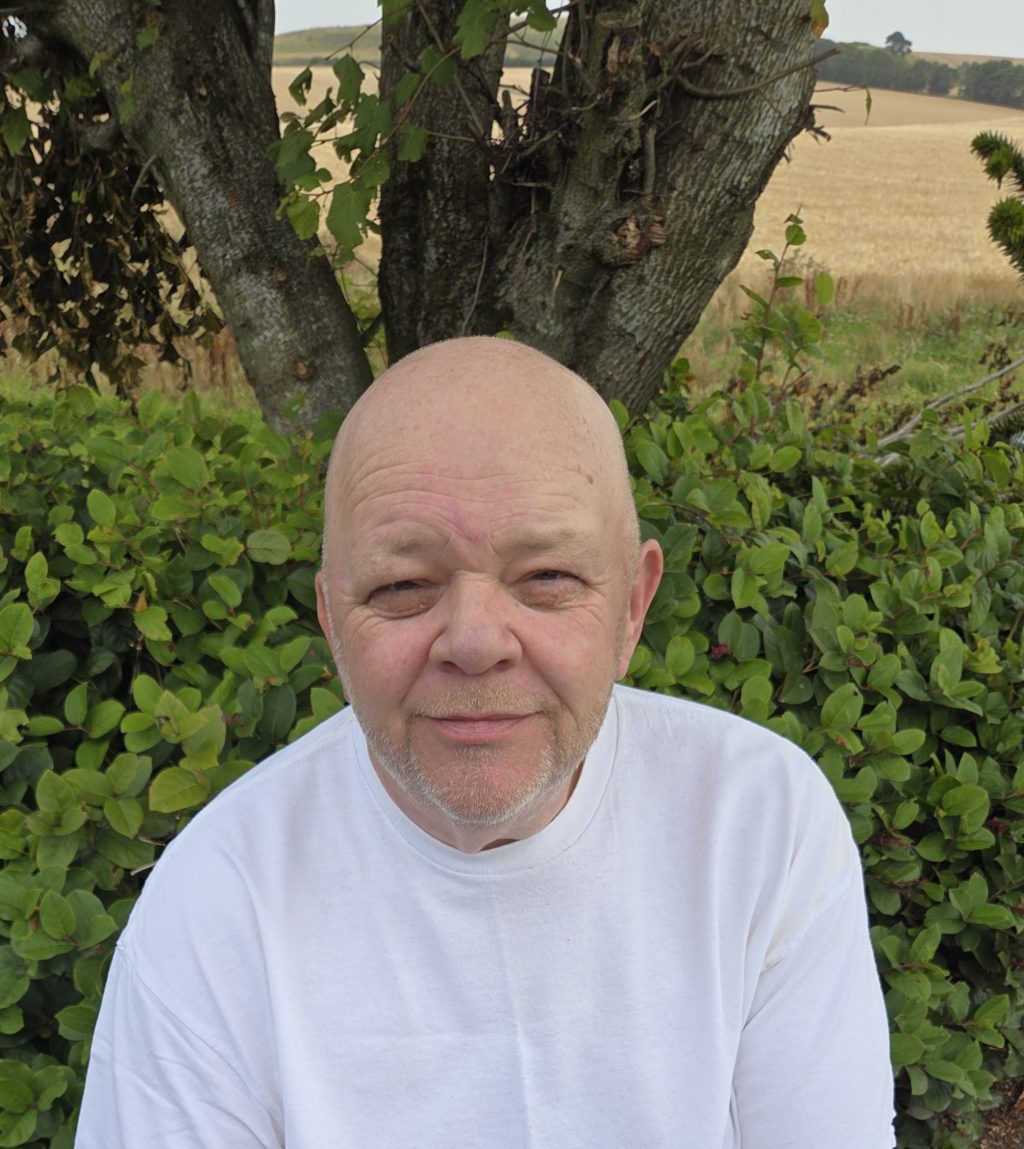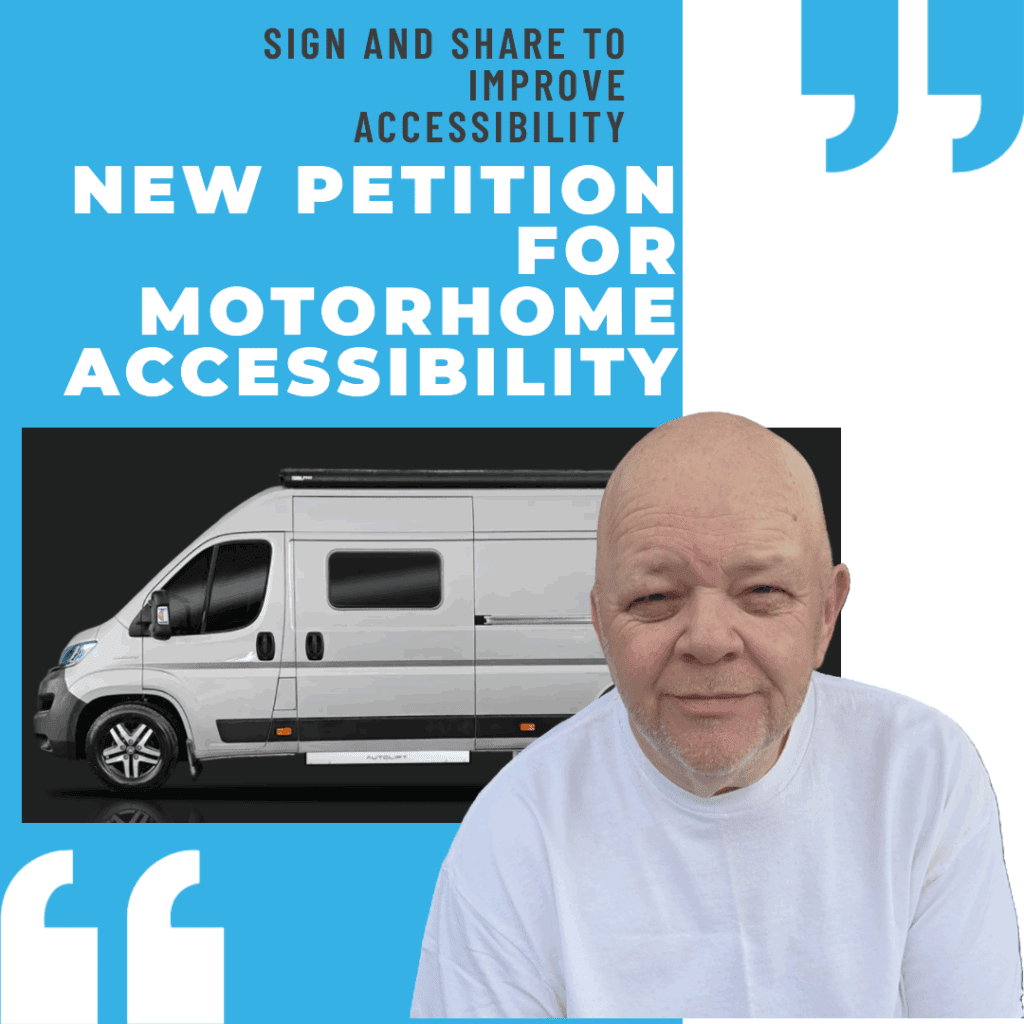Motorhomes for Everyone: Make Accessibility Standard
Key Takeaways
| Point | Summary |
|---|---|
| Current gap | Most motorhomes include powered steps for non-disabled people, but no lift or ramp for wheelchair users. |
| Simple solution | Eddie’s petition calls for a 750mm minimum door width and bracketry for lifts/ramps. |
| Industry opportunity | Accessible design benefits more than just disabled people — it can expand the market. |
| Action needed | Pressure on manufacturers to build accessibility in from the start, not as an afterthought. |
A Motorhome Dream, Stopped at the Door
Eddie thought he’d found the perfect solution when he spotted a second-hand motorhome that had already been converted by a specialist company. It seemed to tick every box: automatic transmission with hand controls, a widened habitation door, cassette lift, and a wet room with brilliant toileting facilities. “Perfect!” he thought.
But when a friend inspected the vehicle more closely, they discovered significant issues that could have made it a very expensive mistake. That setback led Eddie and his partner Di to explore buying new instead — only to discover conversion costs that were, in Eddie’s words, “astronomical.”
For Eddie Thomson, a C6/7 tetraplegic and full-time wheelchair user for 27 years, finding the right vehicle meant securing both independence and dignity. With 105,000 people living with spinal cord injuries in the UK and someone becoming paralysed every two hours, Eddie’s experience reflects a much wider need.
Two Simple Changes to Make Motorhomes More Accessible

Eddie’s petition asks for two straightforward standards that would make motorhomes far easier to use for many disabled people:
- A minimum 750mm habitation door width — enough for most wheelchairs to pass through.
- Bracketry for a cassette lift or ramp — making powered access an option from day one.
These requirements align with existing UK building standards, where regulations already mandate 775mm minimum door widths for accessible dwellings.
As Eddie puts it: “There are electric steps installed on motorhomes to aid the entry of non-disabled people — surely the same courtesy should be extended to disabled people?” It’s a matter of basic fairness: if manufacturers can build in convenience features for walking customers, why not for wheelchair users too?
How to Support Motorhome Accessibility
- Sign the petition: Eddie’s UK Parliament petition
- Share the campaign: Post the petition link on social media and tag major motorhome brands, dealerships, and trade associations.
- Ask before you buy: When talking to manufacturers or dealers, check:
- Is the habitation door at least 750 mm wide?
- Is lift or ramp bracketry fitted as standard?
- Can layout changes for wheelchair access be included?
- Contact industry bodies: Write to the National Caravan Council (NCC) or other trade groups to request accessibility standards.
- Back accessible tourism: Choose campsites, rentals, and holiday providers that clearly publish their accessibility features.
Eddie’s Response to ‘It’s Not Possible’
When asked about accessibility, some in the motorhome industry claim there’s not enough demand. Others suggest the vehicles are simply too small to accommodate wheelchair users.
Eddie, who worked as a design draughtsperson in the oil industry and later as managing director of an architectural design and construction company for over 20 years, sees through these excuses.
“As a design draughtsperson working in the oil industry for many years creating products from an idea through the design stage and then seeing it through the fabrication process to the finished article installed in place and doing the job it was intended for, I was horrified by the conversion prices for such vehicles and really don’t agree with what these companies are charging.”
“The manufacturers haven’t been made to think of how they could make better use of space,” he argues. “Many of the larger A-class motorhomes are four-berth but have seating for 8 people. Would shortening one of those seats by 100mm to fit a wider door be such a hardship?”
His professional experience gives him insight into what’s really possible: “These manufacturers have their own factories with 3D design programs and CNC automation. Cutting out a larger door wouldn’t cost more or produce more waste.” The technology exists — what’s missing is the will to use it inclusively.
Eddie believes the industry hasn’t changed because “nobody has pushed them to do so.” He’s particularly critical of what manufacturers call customisation:
“They say they offer bespoke items but they don’t, they offer you ‘options’ from a specified list.”
Designing for Everyone Makes Sense
Accessible design benefits far more than wheelchair users:
- Parents pushing prams or pushchairs
- Older travellers with mobility issues
- People transporting bulky equipment like bikes or camping gear
Designing with accessibility in mind from the outset allows manufacturers to reach more customers and reduce the expense of later modifications.
The statistics back this up this: disabled people contribute £14.6 billion annually to England’s tourism economy, and 24% of domestic overnight trips involve someone with an impairment.
With the UK motorhome and caravan industry contributing £12 billion annually to the economy and 20% of UK adults have been camping or caravanning post-COVID-19 – this translates to 1 in 5 adults. Accessible design represents significant untapped market potential.
Eddie has seen this transformation happen before:
“I was managing director of a company involved in architectural design & construction for 20 plus years post injury and saw things improve massively for disabled people over that period of time.”
He points to the USA as an example of what’s possible:
“I think the USA has it much better than we have and hope to get over at some point to go on tour in a massive RV. 😁”
Eddie’s Vision for Accessible Travel
For Eddie, an accessible motorhome offers genuine freedom. He plans to begin by touring the UK with his two Boxer dogs, then travel across Europe and beyond.
“I’d just love to be able to independently go and see whatever I wanted,” he explains. “Perhaps a small village in Italy that makes awesome pizzas, maybe a football match in Madrid, a Moto GP in Austria, friends in Southern Spain, Denmark, Germany, Sweden. I want to swim in the Mediterranean, lose money at the casino in Monaco.”
For Eddie and Di, it’s about having the same choices as anyone else: “We could go wherever we wanted to, just as any non-disabled person could. Surely that’s a basic right that should be easily achieved by anyone without having to spend an absolute fortune.”
The Call to Action
Eddie’s petition calls for fair treatment: “Disabled people deserve to be able to go on holiday independently in a motorhome in a dignified manner. To be able to make memories that last a lifetime perhaps for a child, parent, anyone.”
He puts it bluntly:
“Many of us who would want one of these specialised vehicles perhaps can’t use our arms or legs, but we don’t want to have to sell them to buy the motorhome! 😂”
The goal is to improve access for people while shifting the industry’s entire approach to design. “Hopefully we can implement change within the industry and get to realise our dreams.”
📢 Sign the petition here
📢 Share on social media: Tag major brands and ask why they aren’t making space for everyone.
Drawing on his experience in design and construction, Eddie understands how much can be achieved when industries prioritise inclusion. He believes the motorhome sector could follow the same path that once reshaped architecture and public transport. The technology is available, the demand is real — what’s lacking is the commitment to make it happen.


